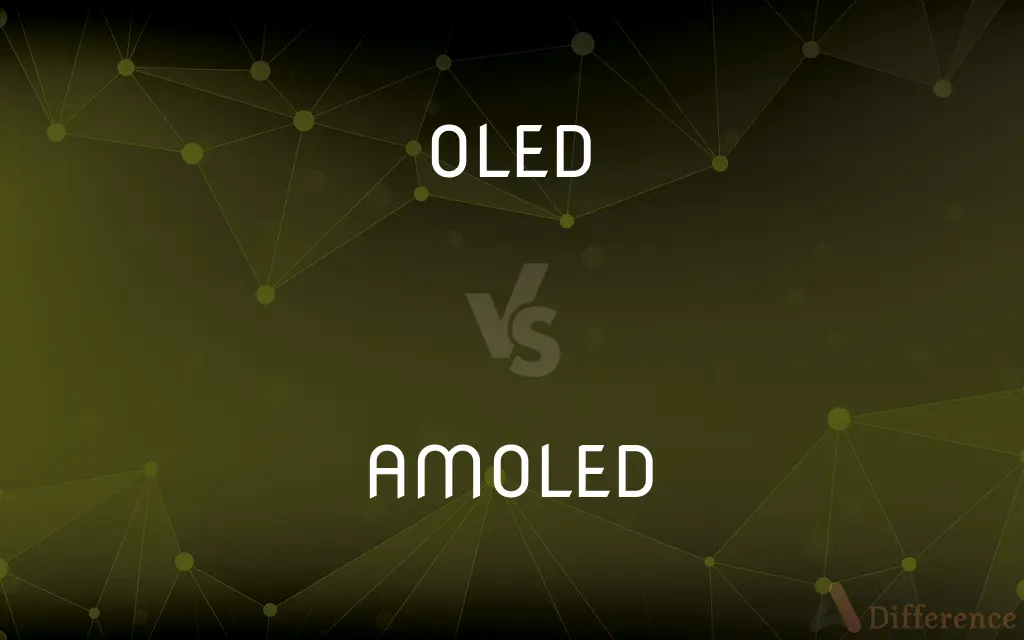OLED vs. AMOLED — What's the Difference?
By Tayyaba Rehman — Published on January 19, 2024
OLED (Organic Light Emitting Diodes) displays use organic compounds to create light. AMOLED (Active Matrix OLED) adds a layer of semiconducting film to control each pixel more precisely.

Difference Between OLED and AMOLED
Table of Contents
ADVERTISEMENT
Key Differences
OLED, standing for Organic Light Emitting Diodes, is a display technology where each pixel is made of organic compounds that emit light when electricity is applied. AMOLED, or Active Matrix OLED, builds upon OLED technology by integrating a thin-film transistor (TFT) layer that allows for more precise control of each pixel, enhancing display performance.
In OLED displays, the illumination of each pixel is controlled directly by applying an electric current. In contrast, AMOLED displays use the additional TFT layer to manage each pixel's color and brightness more efficiently, leading to improved response times and power consumption.
OLED displays are known for their thinness, flexibility, and the ability to produce deep blacks and high contrast ratios. AMOLED displays share these benefits but often exhibit better performance in terms of color accuracy and refresh rates due to the active matrix technology.
While both OLED and AMOLED provide superior viewing experiences compared to traditional LCDs, AMOLEDs are generally more expensive due to their advanced pixel control technology. OLEDs, being the base technology, are more commonly found in a variety of devices including TVs and smartphones.
Energy efficiency is a notable feature of OLEDs as each pixel generates its own light, eliminating the need for backlighting. AMOLEDs further enhance this efficiency, particularly in displaying true blacks and reducing power consumption in dark scenes or modes.
ADVERTISEMENT
Comparison Chart
Technology Base
Organic Light Emitting Diodes
Active Matrix Organic Light Emitting Diodes
Pixel Control
Direct current to pixels
Additional thin-film transistor layer for precise control
Performance
High contrast, deep blacks
Improved color accuracy, faster refresh rates
Cost
Generally less expensive
More expensive due to advanced technology
Energy Efficiency
Efficient due to lack of backlight
Further enhanced efficiency in power management
Compare with Definitions
OLED
OLED stands for Organic Light Emitting Diodes.
The OLED TV displayed incredibly vibrant colors.
AMOLED
AMOLED displays offer improved color accuracy and refresh rates.
The colors on the AMOLED screen were more vibrant than those on standard screens.
OLED
OLED provides high contrast ratios and true blacks.
Watching movies on an OLED screen offered a cinema-like experience.
AMOLED
AMOLED includes a thin-film transistor layer for better pixel control.
The AMOLED screen's fast response time improved the gaming experience.
OLED
OLED technology enables each pixel to emit its own light.
The absence of backlighting in the OLED screen allowed for deeper blacks.
AMOLED
AMOLED enhances energy efficiency in displaying dark scenes.
The dark mode on the AMOLED device significantly saved battery life.
OLED
OLED displays are known for their thinness and flexibility.
The flexible OLED screen was used in the latest foldable smartphone.
AMOLED
AMOLED stands for Active Matrix Organic Light Emitting Diodes.
His new smartphone featured an AMOLED display for enhanced visuals.
OLED
OLED screens are energy efficient.
The OLED display helped conserve battery life on her phone.
AMOLED
AMOLED is more expensive due to its advanced technology.
The high cost of the AMOLED technology was reflected in the smartphone's price.
OLED
A light-emitting diode that uses an organic compound to emit light.
Common Curiosities
What are the advantages of OLED displays?
OLEDs offer high contrast, true blacks, and energy efficiency.
Is the color accuracy better in AMOLED or OLED?
AMOLED generally offers improved color accuracy over standard OLED.
What does OLED stand for?
OLED stands for Organic Light Emitting Diodes.
How does AMOLED differ from OLED?
AMOLED adds a thin-film transistor layer for more precise pixel control.
Why are AMOLED displays more expensive?
They're more expensive due to the additional layer for precise pixel control and performance.
Are AMOLED screens better for smartphones?
Yes, especially for enhanced visuals and energy-efficient dark modes.
Are OLED displays good for energy efficiency?
Yes, OLED displays are energy efficient due to their self-illuminating pixels.
Which display technology is more common in TVs?
OLED is more commonly used in TVs.
Are there any downsides to OLED technology?
OLED can suffer from burn-in over time, where images are retained on the screen.
Do both OLED and AMOLED offer high resolution?
Yes, both can support high-resolution displays.
Do OLED screens require backlighting?
No, OLED pixels generate their own light and don't need backlighting.
Can OLED displays be used in flexible screens?
Yes, the flexibility of OLED technology is suitable for foldable or curved screens.
What makes AMOLED displays ideal for gaming?
Their faster refresh rates and response times make them ideal for gaming.
Are AMOLED displays visible in direct sunlight?
Yes, AMOLED displays perform well in various lighting conditions, including direct sunlight.
Can AMOLED displays save battery life?
Yes, particularly when displaying dark scenes or using dark mode.
Share Your Discovery

Previous Comparison
Excedrin Migraine vs. Excedrin Extra Strength
Next Comparison
Wacom One vs. Wacom IntuosAuthor Spotlight
Written by
Tayyaba RehmanTayyaba Rehman is a distinguished writer, currently serving as a primary contributor to askdifference.com. As a researcher in semantics and etymology, Tayyaba's passion for the complexity of languages and their distinctions has found a perfect home on the platform. Tayyaba delves into the intricacies of language, distinguishing between commonly confused words and phrases, thereby providing clarity for readers worldwide.
















































